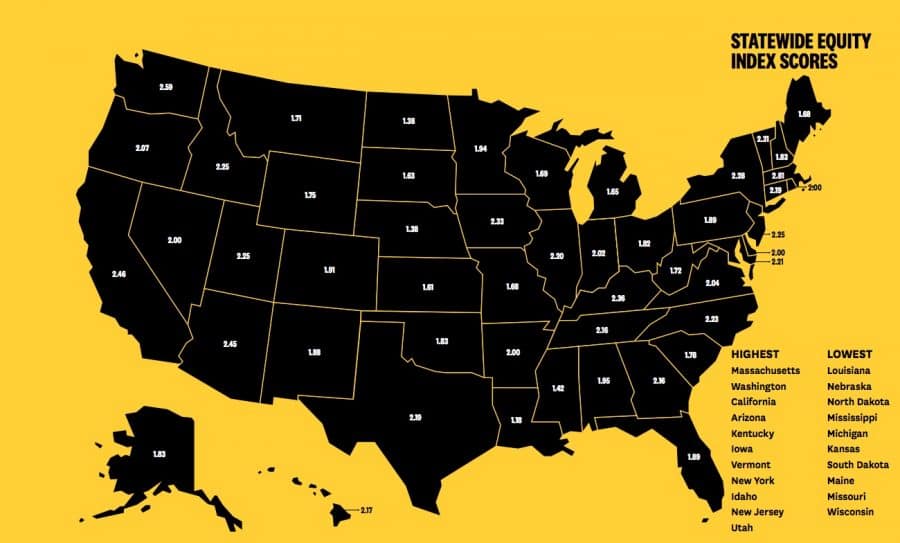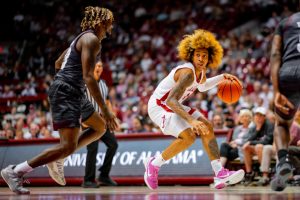Racial equity study gives the University an ‘F’
October 8, 2018
A study on racial equity gave The University of Alabama a grade of F based on the number of black undergraduate students enrolled at the University.
The study, entitled “Black Students at Public Colleges and Universities: a 50 state report card,” was conducted by the University of Southern California Race and Equity Center and includes information on 506 public colleges and universities. It combines U.S. Census population statistics with quantitative data from the U.S. Department of Education to measure postsecondary access and student success for black undergraduates at public universities in all 50 states. Letter grades of A, B, C, D, F and I (incomplete) are then given to different aspects of diversity, which translate into an overall grade for each institution.
The letter grades correspond to a number between zero and four with A being four and F being zero. These numbers are then used to calculate their equity index. The University earned an equity index of 1.50. The average score of all of the 506 public colleges and universities in the study was 2.02, with 200 of them earning less than two. No school earned a score higher than 3.50.
G. Christine Taylor, vice president and associate provost for diversity, equity and inclusion for the University, said the study presents an opportunity for the University to look at what ways it can be more effective in pursuing diversity and removing barriers to success for all students.
“Increasingly, employers are saying to us that it is important for us to have students who come to us with the ability to work effectively and efficiently with students who are different than themselves,” Taylor said. “So college is a wonderful preparation space for the life that students are going to be working in, which is an increasingly diverse global society. We need to make sure that we are a campus in which everyone can succeed because this is about the world that students are going to work and live in once they graduate.”
Black citizens make up 14.6 percent of 18 to 24 year olds in the country. However, only 9.8 percent of full-time undergraduate students at public colleges and universities are black. The study shows that black students aged 18 to 24 are under-enrolled at more than three-fourths of public institutions in the country.
According to the study, black students aged 18 to 24 make up 10 percent of the University’s undergraduate students. Black students make up 32.3 percent of the black population between the ages of 18 to 24 years old in Alabama in 2016.
The study also measured the gender gap between black undergraduate men and women enrolled at public universities in relation to the national gender enrollment distribution across all racial and ethnic groups, the completion rate among black undergraduate students and the black-student-to-black-faculty ratio. The University earned a C grade in these three areas.
Teryn Shipman, coordinating student assistant for the Intercultural Diversity Center, said she wasn’t surprised by the study’s findings, and it should motivate the University to do more to increase its diversity among students and faculty.
“I definitely think that the study only showed us what we already know to be true,” Shipman said. “I think that the study should put a fire under the University’s butt to actually stand firm and true in that, if they’re going to create these titles of diversity, equity and inclusion, then they need to truly fund those and support the groups on campus that don’t have resources like Safe Zone and the Intercultural Diversity Center. Numbers are black and white, so no one can negate something that’s shown to us through numbers and statistics.”
Isaiah Simmons, a graduate research assistant at the University of Southern California and co-author of the study, said the purpose of studies like this is for universities to know where they stand with their diversity, so they can then work toward ensuring that all students are represented.
“In every state, we saw that there was a school that did something well,” Simmons said. “So other universities can look at other schools that scored higher and reach out to them to learn about what they’re doing so they can then implement changes into their own school and improve their own equity.”
Public colleges and universities are supported by the tax dollars of not just one group, but of everyone, Simmons said. Because everyone pays into the system that keeps these schools up and running, it is only fair those institutions work to be proportional in their representation of everyone.
Institutions that received a low grade should not be discouraged, Simmons said. Rather, this should be a learning experience for them to renew their commitment to diversity and inclusion and to ensure that success is attainable for all students.
“Reports like this show schools where they are doing well and show them what areas they need to improve on, so they can go about doing that,” Simmons said. “All of those things go toward showing a sense of belonging and a sense of mattering to students on college campuses.”
The full study can be read here: https://race.usc.edu/wp-content/uploads/2018/09/Black-Students-at-Public-Colleges-and-Universities-A-50-State-Report-Card-Harper-and-Simmons-1-9-26.pdf





















